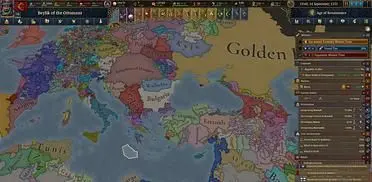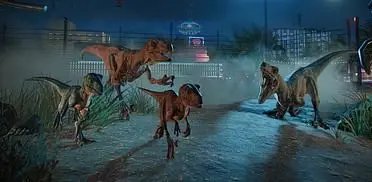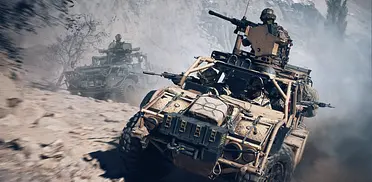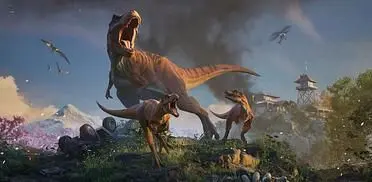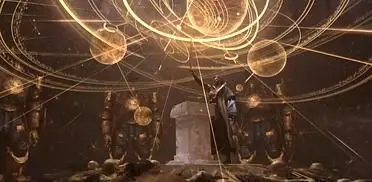Despite being a ‘MOBA’, it’s more akin to a reverse Tower Defence game, just with less emphasis on towers and more emphasis on the units. There are three main layers to the game – Management, PvE and PvP. The latter two are essentially the same, as fighting in EWO is the same, but the set-up is slightly different. The management layer is where we envision you spending most of your time and effort, although ironically it’s the part of the game we saw the least of. You choose one of the three factions from the original EndWar to play as – the Russian Federation, the European Federation and the United States. EndWar’s timeline is ten years after the start of WWIII in the original game, and unsurprisingly the world is kind of in ruins. You’re not so much fighting over whose best as you are fighting over what’s left.
 |
| The only map we went hands-on with, we’re not sure how typical this set-up will be |
In the ‘management’ view, the player re-occupies the faction capital, in Europe’s case this is Paris (pah!). This is where you build your army of ‘heroes’, research new tech and upgrades, and fiddle with your loadouts. There are 9 basic classes in EWO – Tank, Mechanised, Infantry, Helicopters, Drones, Transports and Jets. You recruit ‘heroes’ from these classes into your army, and you can tweak their ability and load-outs in the management view as well. Each hero has slots for equipment, so you can further diversify heroes within the same class. The customisation element of this game seems really involved and deep, with a lot of the fine-tuning that you’d expect from a game that’s clearly being aimed at a competitive-play market.
PvE’s set-up follows a scripted story – you have ten chapters, and each chapter contains five missions. Within those missions, you have to fight ten battles, so already you can see the team have put a lot of effort into making sure there’s plenty of comp-stomp content for you. PvP is a little different – they’ve brought back the Global Map from EndWar, and it’s divided into Theatres of War. There will be certain contested territories (not sure who chooses them), and the factions in question have to fight over those territories. The faction with the most ‘wins’ at the end of a time period will win the territory. Each territory will have multiple fights/stages that you can fight over – winning the early stages will make winning the ‘final’ stage easier.
The actual combat in EndWar Online is an odd experience. It’s almost as if the ‘fighting’ part is academic, that it’s simply a way for you to visually confirm that you made the right choices when you were tweaking and recruiting your heroes in the management screen. From what we can tell so far, every map is going to be pretty small, with engagements lasting 5, maybe ten minutes. Every map has three lanes, like any good MOBA, but you don’t get to control your units – all you do is select your heroes, choose which lane to assign him/her too, and then watch as they trundle along the lane. If they encounter an enemy, the two forces fight it out until one wins, if they manage to get to the opposing base, they start hammering away until either they or it is destroyed. Destroy the base and you win. EndWar Online keeps the Rock, Paper, Scissors dynamic from the original game, so lane management essentially boils down to just reacting to what your opponent has on any given lane. There’s scope for tactics – anticipation of what your opponent will play, taking advantage of an empty lane, etc... Every unit, depending on how you outfit them, will have a special ability they can employ, and some heroes like the Jet Bomber actually act as off-map support, instead of moving along a lane.
 |
| Where I reckon players will spend most of their time. Paying attention to these stats could win you the fight before it even starts |
This lack of control is certainly different to anything you’d play currently, and seems almost ‘retro’ in its design. With matches being so short as well, you don’t really have much time to try and claw your way back from a bad footing – the tweaking and fine-tuning of your heroes then is going to be key, which is good in a way because there’s nothing a competitive community likes more than comparing and testing out load-outs, and it makes for a good competitive scene. It’s a free-to-play title, as you’d expect, but they’re not talking about the monetisation right now… from just looking at the game though, we could imagine everything from skins, to weapon/mods to new PvE campaigns being part of the plan.
There’s still a heavy stigma attached to browser-based gaming, and it remains to be seen whether EndWar Online can do much to combat that. So far it’s shaping up to be a perfectly competent, albeit limited, MOBA experience, but the IP is pretty much the best bit: it’s good to see the EndWar license hasn’t been forgotten. The best thing this game can do is garner enough revenue and interest, so that we get the full-blown sequel that was ‘shelved’ back in 2010. EndWar Online is due out sometime next year, with a Beta due before Christmas.
Most Anticipated Feature: We’d really like to see the management and Heroes/Unit development portion of the game. That’s where most of the focus of this game is going to rest.
